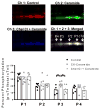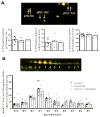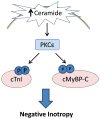Ceramide-mediated depression in cardiomyocyte contractility through PKC activation and modulation of myofilament protein phosphorylation
- PMID: 25280528
- PMCID: PMC4440670
- DOI: 10.1007/s00395-014-0445-6
Ceramide-mediated depression in cardiomyocyte contractility through PKC activation and modulation of myofilament protein phosphorylation
Abstract
Although ceramide accumulation in the heart is considered a major factor in promoting apoptosis and cardiac disorders, including heart failure, lipotoxicity and ischemia-reperfusion injury, little is known about ceramide's role in mediating changes in contractility. In the present study, we measured the functional consequences of acute exposure of isolated field-stimulated adult rat cardiomyocytes to C6-ceramide. Exogenous ceramide treatment depressed the peak amplitude and the maximal velocity of shortening without altering intracellular calcium levels or kinetics. The inactive ceramide analog C6-dihydroceramide had no effect on myocyte shortening or [Ca(2+)]i transients. Experiments testing a potential role for C6-ceramide-mediated effects on activation of protein kinase C (PKC) demonstrated evidence for signaling through the calcium-independent isoform, PKCε. We employed 2-dimensional electrophoresis and anti-phospho-peptide antibodies to test whether treatment of the cardiomyocytes with C6-ceramide altered myocyte shortening via PKC-dependent phosphorylation of myofilament proteins. Compared to controls, myocytes treated with ceramide exhibited increased phosphorylation of myosin binding protein-C (cMyBP-C), specifically at Ser273 and Ser302, and troponin I (cTnI) at sites apart from Ser23/24, which could be attenuated with PKC inhibition. We conclude that the altered myofilament response to calcium resulting from multiple sites of PKC-dependent phosphorylation contributes to contractile dysfunction that is associated with cardiac diseases in which elevations in ceramides are present.
Conflict of interest statement
None
Figures










Similar articles
-
Protein kinase C depresses cardiac myocyte power output and attenuates myofilament responses induced by protein kinase A.J Muscle Res Cell Motil. 2012 Dec;33(6):439-48. doi: 10.1007/s10974-012-9294-9. Epub 2012 Apr 22. J Muscle Res Cell Motil. 2012. PMID: 22527640 Free PMC article.
-
Propofol decreases myofilament Ca2+ sensitivity via a protein kinase C-, nitric oxide synthase-dependent pathway in diabetic cardiomyocytes.Anesthesiology. 2006 May;104(5):978-87. doi: 10.1097/00000542-200605000-00014. Anesthesiology. 2006. PMID: 16645450
-
Interventricular differences in myofilament function in experimental congestive heart failure.Pflugers Arch. 2011 Dec;462(6):795-809. doi: 10.1007/s00424-011-1024-4. Epub 2011 Sep 17. Pflugers Arch. 2011. PMID: 21927813 Free PMC article.
-
Ceramide regulates cellular homeostasis via diverse stress signaling pathways.Leukemia. 2001 Aug;15(8):1153-60. doi: 10.1038/sj.leu.2402197. Leukemia. 2001. PMID: 11480555 Review.
-
Regulation of phospholamban and troponin-I phosphorylation in the intact rat cardiomyocytes by adrenergic and cholinergic stimuli: roles of cyclic nucleotides, calcium, protein kinases and phosphatases and depolarization.Mol Cell Biochem. 1995 Aug-Sep;149-150:103-26. doi: 10.1007/BF01076569. Mol Cell Biochem. 1995. PMID: 8569720 Review.
Cited by
-
Silencing of Sphingosine kinase 1 Affects Maturation Pathways in Mouse Neonatal Cardiomyocytes.Int J Mol Sci. 2021 Mar 31;22(7):3616. doi: 10.3390/ijms22073616. Int J Mol Sci. 2021. PMID: 33807180 Free PMC article.
-
Role of Ceramides in the Molecular Pathogenesis and Potential Therapeutic Strategies of Cardiometabolic Diseases: What we Know so Far.Front Cell Dev Biol. 2022 Jan 19;9:816301. doi: 10.3389/fcell.2021.816301. eCollection 2021. Front Cell Dev Biol. 2022. PMID: 35127726 Free PMC article. Review.
-
Getting to the heart of the sphingolipid riddle.Curr Opin Physiol. 2018 Feb;1:111-122. doi: 10.1016/j.cophys.2017.10.002. Epub 2017 Dec 13. Curr Opin Physiol. 2018. PMID: 33195889 Free PMC article.
-
Magnetic resonance reveals early lipid deposition in murine prediabetes as predictive marker for cardiovascular injury.Npj Imaging. 2024 Sep 23;2(1):36. doi: 10.1038/s44303-024-00044-0. Npj Imaging. 2024. PMID: 40604298 Free PMC article.
-
Measurement of Myofilament-Localized Calcium Dynamics in Adult Cardiomyocytes and the Effect of Hypertrophic Cardiomyopathy Mutations.Circ Res. 2019 Apr 12;124(8):1228-1239. doi: 10.1161/CIRCRESAHA.118.314600. Circ Res. 2019. PMID: 30732532 Free PMC article.
References
-
- Ayaz-Guner S, Zhang J, Li L, Walker JW, Ge Y. In vivo phosphorylation site mapping in mouse cardiac troponin I by high resolution top-down electron capture dissociation mass spectrometry: Ser22/23 are the only sites basally phosphorylated. Biochemistry. 2009;48:8161–8170. doi: 10.1021/bi900739f. - DOI - PMC - PubMed
-
- Bielawska A, Crane HM, Liotta D, Obeid LM, Hannun YA. Selectivity of ceramide-mediated biology. Lack of activity of erythro-dihydroceramide. J Biol Chem. 1993;268:26226–26232. - PubMed
-
- Brutsaert DL, Sys SU. Relaxation and diastole of the heart. Physiol Rev. 1989;69:1228–1315. - PubMed
Publication types
MeSH terms
Substances
Grants and funding
LinkOut - more resources
Full Text Sources
Other Literature Sources
Research Materials
Miscellaneous

